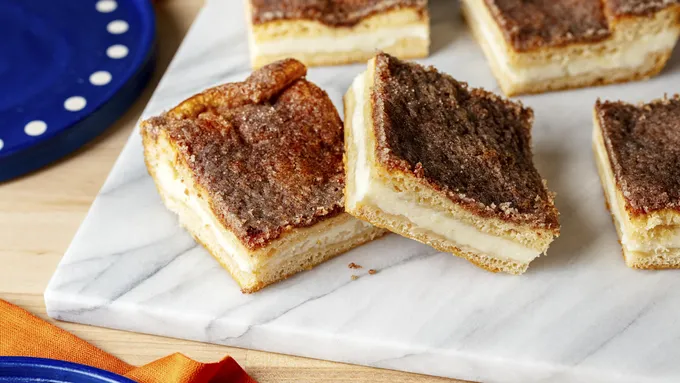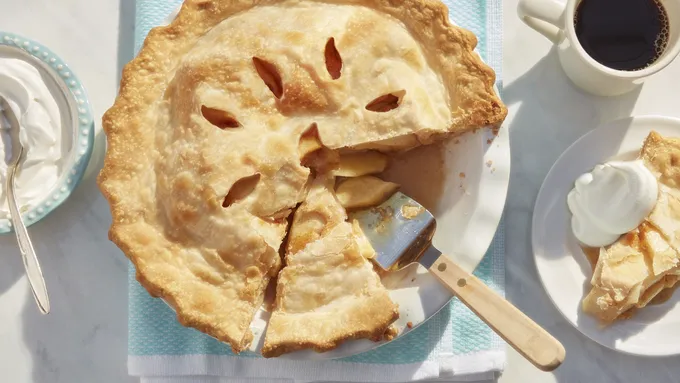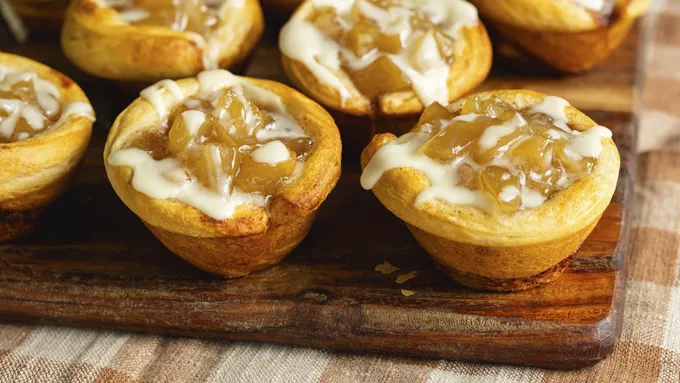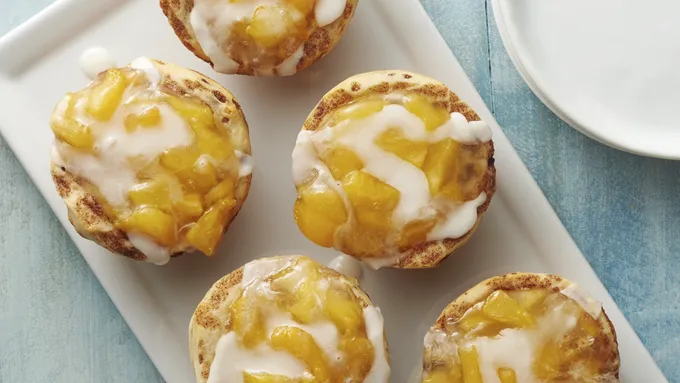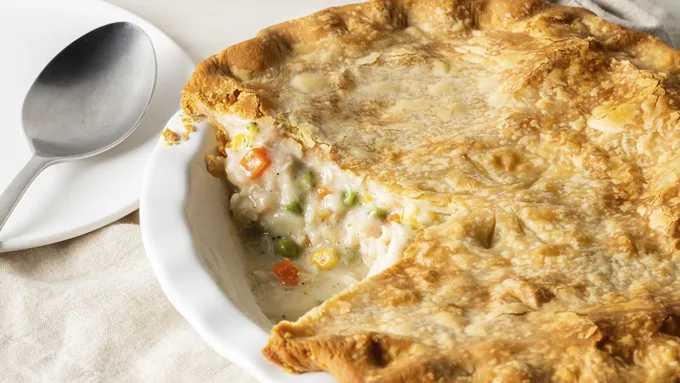What is Buttermilk?
When you pour buttermilk out of its container, you may notice that while it looks like milk, it’s thicker than milk and may even be a little lumpy. This is because buttermilk is essentially fermented milk. While milk is a fresh dairy product, buttermilk is cultured. It is fermented with active bacteria, similar to yogurt.
Traditionally, buttermilk was made from the liquid left over from churning homemade butter out of cultured cream. When butter was churned at home, the liquid portion was left out overnight to ferment. Now, we purchase cultured buttermilk at the store that is fermented in a controlled environment.
In terms of flavor, buttermilk is fairly tart, almost like plain yogurt. And when you add it to recipes, it provides tangy flavor as well as taller, lighter baked goods, thanks to the acids formed by the fermentation process.
What are Common Challenges?
Buttermilk pie is a very easy pie to make, but with any recipe, there are common issues that can arise. Thankfully, they are also easy to avoid! Be sure to follow the recipe exactly as written and read our Kitchen Tips below for more ways to make sure you bake up a pie to be proud of.
To make the best buttermilk pie, it’s important to follow the indicators of doneness in the recipe. Some common challenges bakers have with buttermilk pie:
The Filling is not Fully Set after Baking
For this pie, you want to make sure the filling is mostly set—it will jiggle slightly, but not slosh around. The top of the pie should also be a light golden-brown color when it’s done baking. The pie will continue to set fully as it cools.
The Top of the Pie is Cracked
To keep the pie from cracking, don’t open the oven door to check on the pie! Keep it closed as much as possible, as temperature fluctuations can cause cracking in a custard pie.
The Ingredients Have Separated During Baking
To prevent ingredients from separating during baking, make sure the eggs, butter and buttermilk for the filling are all at room temperature before mixing them together. That said, some butter may still leak from the pie in the oven. To prevent any burned bits on the oven floor, we recommend placing a piece of foil on the oven rack below the pie before baking.
What Should I Use for the Crust?
For buttermilk pie recipes, the most commonly used crust is a standard pie crust. You can use a homemade crust or a store-bought pie crust for this recipe, such as Pillsbury™ Pie Crust, which makes quick work of the flaky, buttery base of this pie.
To use Pillsbury™ Pie Crust in this buttermilk pie recipe, simply follow the instructions on the box for a One-Crust Filled Pie. You can decorate the edges of the pie any way you like —scalloped, pinched, forked, herringbone, etc.
If the crust is getting too brown during baking, you can cover the edges of the crust with foil. You can find details on how to do this in the recipe below, but essentially, it keeps the crust nice and golden while the filling has a chance to finish baking.
How to Store
Once baked and fully cooled, buttermilk pie should be stored in the fridge, tightly covered with plastic wrap or aluminum foil, for up to four days. You can serve the pie cold or at room temperature—both ways are delicious! As for toppings, be sure to check out our Kitchen Tips below for our favorite options.
Can I Freeze Buttermilk Pie? Yes, you absolutely can! You can freeze the pie whole or in slices. Wrap either the whole pie or slices of pie in plastic wrap, then tightly in foil. Freeze the pie for up to three months. Thaw the pie or pie slices overnight in the fridge before serving.
Can I Freeze Buttermilk Pie?
Yes, you absolutely can! You can freeze the pie whole or in slices. Wrap either the whole pie or slices of pie in plastic wrap, then tightly in foil. Freeze the pie for up to three months. Thaw the pie or pie slices overnight in the fridge before serving.
Frequently Asked Questions
What Can I add to My Buttermilk Pie?
Even the simplest buttermilk pie is delicious in every way, but we bakers love to make recipes our own! There are several ingredients you can add to your buttermilk pie to make it extra-special and extra-unique to you and those you share it with.
Add-Ins: You can add 1 teaspoon vanilla extract to the filling for added sweetness, or add 1/8 teaspoon ground nutmeg to the filling for a warm, cozy flavor.
Toppings: Check out our Kitchen Tips for some of our favorite toppings! You can also add a dash of nutmeg, extra lemon zest or a spoonful of peach pie filling to the top of each slice.
Looking to Serve this Pie with Something to Drink? Sweet tea or iced tea are both greats drink to serve on the side of buttermilk pie. You can also pair a slice with orange juice for brunch or fresh lemonade on a hot summer day.
What is the Difference Between Buttermilk Pie and Chess Pie?
While both a chess pie recipe and a buttermilk pie recipe may seem similar in ingredients and results, the main differences between the two is that chess pies are often baked with whole milk (instead of buttermilk), and chess pies incorporate both flour and cornmeal into the filling, rather than just flour.
Where Did Buttermilk Pie Come From?
Traditional buttermilk pie has its roots in America in the South, but it actually originated from England and was introduced in the United States by settlers. The pie recipe quickly took off in the South, where buttermilk was a staple in many home kitchens. Southern buttermilk pie was often baked as an alternative to fruit pies when fruit was not as plentiful, but dessert was still part of the menu. Nowadays, you can find buttermilk pie almost everywhere.
(function() {
document.addEventListener('DOMContentLoaded', function() {
var componentMetadata = JSON.parse('\x7b\x22componentName\x22\x3a\x22RecipeFAQ_e8af84a8-5198-47ca-bc1c-daf22247ecf7\x22,\x22deferOptions\x22\x3a\x7b\x22deferComponent\x22\x3afalse,\x22deferType\x22\x3a\x22None\x22,\x22deferId\x22\x3a\x22r1a5103e171c94f55b575a0b97207e04a\x22,\x22deferredContainerId\x22\x3a\x22\x2fmain\x2frdpFAQ\x22,\x22deferredContainerView\x22\x3anull\x7d,\x22viewName\x22\x3a\x22RecipeFAQ\x22\x7d');
var configuration = {"title":"Buttermilk Pie","introduction":"\u003cp\u003eIf you’ve never had the pleasure of enjoying a slice (or three) of Buttermilk Pie, you are in for a treat—literally! Buttermilk Pie is a classic pie recipe that has been around for decades, but it seems to stay under the radar while other pies tend to take over the spotlight. While Buttermilk Pie may be simple in appearance, its flavor is anything but. We will never judge a pie by its looks alone—the taste test is the best part, and we’re here to prove it with this southern buttermilk pie recipe!\u003c/p\u003e\n\u003cp\u003eWhat is Buttermilk Pie? Buttermilk pie is an American pie that features a rich, tangy, creamy, custard-like filling made with—you guessed it—buttermilk, along with a handful of other staple ingredients such as butter, eggs, flour and sugar. It is traditionally a Southern dessert, though in recent years its popularity has spread all over the country and beyond. Some recipes, like ours, will include lemon juice or lemon zest to add tanginess to the filling, and some recipes will include ground nutmeg or vanilla extract for added flavor. Some compare the flavor of buttermilk pie to crème brûlée or chess pie, though buttermilk pie stands in a category all its own with its distinct combination of sweetness and tanginess. It is neither overly sweet nor overly buttery, but blends the two together in one easy-to-make filling. In short, we’ve found a new favorite in this old-fashioned pie. \u003c/p\u003e\n\u003cp\u003e When Is Buttermilk Pie Usually Served? Buttermilk pie can be served any time an occasion calls for pie! Usually, buttermilk pie is served as a dessert, but because it is not as sweet as many other pie recipes, it can also make a delightful addition to a brunch or breakfast spread. See the How to Store section for more tips on how to serve this delish dish. \u003c/p\u003e","servingSize":"1 Slice","image":{"small":{"media":"(min-width: 0px)","src":"https://mojo.generalmills.com/api/public/content/ygQlguTPTT6jv1xnkJUWEA_webp_base.webp?v=d574b004\u0026t=e724eca7b3c24a8aaa6e089ed9e611fd"},"medium":{"media":"(min-width: 500px)","src":"https://mojo.generalmills.com/api/public/content/ygQlguTPTT6jv1xnkJUWEA_webp_base.webp?v=d574b004\u0026t=191ddcab8d1c415fa10fa00a14351227"},"large":{"media":"(min-width: 767px)","src":"https://mojo.generalmills.com/api/public/content/ygQlguTPTT6jv1xnkJUWEA_webp_base.webp?v=d574b004\u0026t=191ddcab8d1c415fa10fa00a14351227"},"alt":"Buttermilk Pie"},"contributor":{"label":"By","name":"Pillsbury Kitchens","profileUrl":"/about-us","displayDate":{"label":"Updated","date":"Aug 27, 2024"}},"ingredientGroups":[{"ingredients":[{"quantity":"1","description":"crust from 1 box (14.1 oz) refrigerated Pillsbury™ Pie Crusts (2 Count), softened as directed on box","productLink":"/products/pie-crust/refrigerated-pie-crust"},{"quantity":"1 1/2","description":"cups sugar"},{"quantity":"1/4","description":"cup all-purpose flour"},{"quantity":"3","description":"eggs"},{"quantity":"1","description":"cup buttermilk"},{"quantity":"1/2","description":"cup butter, melted and cooled slightly"},{"quantity":"1","description":"tablespoon lemon juice"},{"quantity":"1","description":"teaspoon vanilla"}]}],"steps":[{"description":"Heat oven to 350°F. Place pie crust in 9-inch glass pie plate as directed on box for One-Crust Filled Pie.","stepShotImageUrl":"//mojo.generalmills.com/api/public/content/kOqI8XvgTsaCANoqv1Q-8Q_webp_base.webp?v=831073a8\u0026t=51a43a57af4046789e5a7f20567b1195"},{"description":"In large bowl, mix sugar and flour. In separate large bowl, beat eggs with whisk until frothy and light; beat in buttermilk, butter, lemon juice and vanilla until blended. Add sugar-flour mixture; beat until blended and smooth.","stepShotImageUrl":"//mojo.generalmills.com/api/public/content/SwVd4JbHS9aN0Th3QGksnw_webp_base.webp?v=cadbf6f5\u0026t=51a43a57af4046789e5a7f20567b1195"},{"description":"Pour filling into crust-lined plate. Place pie on middle oven rack; place piece of foil on oven rack below middle rack to catch drips. Bake 40 to 50 minutes until center is only slightly jiggly and top of pie is lightly golden. Cover pie crust with foil halfway through baking if getting too brown.","stepShotImageUrl":"//mojo.generalmills.com/api/public/content/3Aw0VOyrR4-ebkjSw7iLFw_webp_base.webp?v=6c114edf\u0026t=51a43a57af4046789e5a7f20567b1195"},{"description":"Cool completely on cooling rack, about 2 hours. Store tightly covered in refrigerator for up to 4 days.","stepShotImageUrl":"//mojo.generalmills.com/api/public/content/9eJkTYg6QtGNvR02aninaQ_webp_base.webp?v=e42242ee\u0026t=51a43a57af4046789e5a7f20567b1195"}],"tips":[{"title":"","description":"This old-fashioned dessert is bound to be a new favorite! Buttermilk Pie is a tried-and-true recipe with a sweet custard filling in a flaky pie crust.","category":"Rich Snippet","tipShots":[]},{"title":"","description":"Be sure to press pie crust firmly into the bottom and side of the pie plate to keep the pie crust from shrinking during baking.","category":"Method Note","tipShots":[]},{"title":"","description":"Top whole pie or individual slices with whipped cream and fresh berries or a dusting of powdered sugar, if desired.","category":"Serving Suggestions/Menu","tipShots":[]},{"title":"","description":"Add 1 teaspoon fresh lemon zest to the pie filling for added flavor.","category":"Variation","tipShots":[]},{"title":"","description":"Be sure to allow pie to cool completely before slicing; otherwise, the filling may not be fully set.","category":"Method Note","tipShots":[]},{"title":"","description":"Kitchen Tested: 5/2024","category":"Kitchen Tested","tipShots":[]}],"kitchenTips":[{"title":"","description":"Be sure to press pie crust firmly into the bottom and side of the pie plate to keep the pie crust from shrinking during baking.","category":"Method Note","tipShots":[]},{"title":"","description":"Top whole pie or individual slices with whipped cream and fresh berries or a dusting of powdered sugar, if desired.","category":"Serving Suggestions/Menu","tipShots":[]},{"title":"","description":"Add 1 teaspoon fresh lemon zest to the pie filling for added flavor.","category":"Variation","tipShots":[]},{"title":"","description":"Be sure to allow pie to cool completely before slicing; otherwise, the filling may not be fully set.","category":"Method Note","tipShots":[]}],"additionalContent":[{"title":"What is Buttermilk?","description":"\u003cp\u003eWhen you pour buttermilk out of its container, you may notice that while it looks like milk, it’s thicker than milk and may even be a little lumpy. This is because buttermilk is essentially fermented milk. While milk is a fresh dairy product, buttermilk is cultured. It is fermented with active bacteria, similar to yogurt.\u003c/p\u003e \n\u003cp\u003eTraditionally, buttermilk was made from the liquid left over from churning homemade butter out of cultured cream. When butter was churned at home, the liquid portion was left out overnight to ferment. Now, we purchase cultured buttermilk at the store that is fermented in a controlled environment.\u003c/p\u003e\n\u003cp\u003eIn terms of flavor, buttermilk is fairly tart, almost like plain yogurt. And when you add it to recipes, it provides tangy flavor as well as taller, lighter baked goods, thanks to the acids formed by the fermentation process.\u003c/p\u003e","category":"SEO Content_1","tipShots":[]},{"title":"What are Common Challenges?","description":"Buttermilk pie is a very easy pie to make, but with any recipe, there are common issues that can arise. Thankfully, they are also easy to avoid! Be sure to follow the recipe exactly as written and read our \u003cb\u003eKitchen Tips\u003c/b\u003e below for more ways to make sure you bake up a pie to be proud of.\u003c/p\u003e\n\u003cp\u003eTo make the best buttermilk pie, it’s important to follow the indicators of doneness in the recipe. Some common challenges bakers have with buttermilk pie:\u003c/p\u003e\n\u003ch3\u003e\u003cb\u003eThe Filling is not Fully Set after Baking\u003c/b\u003e\u003c/h3\u003e \n\u003cp\u003eFor this pie, you want to make sure the filling is mostly set—it will jiggle slightly, but not slosh around. The top of the pie should also be a light golden-brown color when it’s done baking. The pie will continue to set fully as it cools.\u003c/p\u003e\n\u003ch3\u003e\u003cb\u003eThe Top of the Pie is Cracked\u003c/b\u003e\u003c/h3\u003e\n\u003cp\u003eTo keep the pie from cracking, don’t open the oven door to check on the pie! Keep it closed as much as possible, as temperature fluctuations can cause cracking in a custard pie. \u003c/p\u003e\n\u003ch3\u003e\u003cb\u003eThe Ingredients Have Separated During Baking\u003c/b\u003e\u003c/h3\u003e\n\u003cp\u003eTo prevent ingredients from separating during baking, make sure the eggs, butter and buttermilk for the filling are all at room temperature before mixing them together. That said, some butter may still leak from the pie in the oven. To prevent any burned bits on the oven floor, we recommend placing a piece of foil on the oven rack below the pie before baking. \u003c/p\u003e","category":"SEO Content_2","tipShots":[]},{"title":"What Should I Use for the Crust?","description":"For buttermilk pie recipes, the most commonly used crust is a standard pie crust. You can use a homemade crust or a store-bought pie crust for this recipe, such as \u003ca href=\u0022https://www.pillsbury.com/products/pie-crust/\u0022\u003ePillsbury™ Pie Crust\u003c/a\u003e, which makes quick work of the flaky, buttery base of this pie. \u003c/p\u003e\n\u003cp\u003eTo use Pillsbury™ Pie Crust in this buttermilk pie recipe, simply follow the instructions on the box for a One-Crust Filled Pie. You \u003ca href=\u0022https://www.pillsbury.com/everyday-eats/desserts/pies-tarts/special-touches-for-your-crust/\u0022\u003ecan decorate the edges of the pie\u003c/a\u003e any way you like —scalloped, pinched, forked, herringbone, etc.\u003c/p\u003e \n\u003cp\u003eIf the crust is getting too brown during baking, you can cover the edges of the crust with foil. You can find details on how to do this in the recipe below, but essentially, it keeps the crust nice and golden while the filling has a chance to finish baking.\u003c/p\u003e","category":"SEO Content_3","tipShots":[]},{"title":"How to Store ","description":"Once baked and fully cooled, buttermilk pie should be stored in the fridge, tightly covered with plastic wrap or aluminum foil, for up to four days. You can serve the pie cold or at room temperature—both ways are delicious! As for toppings, be sure to check out our \u003cb\u003eKitchen Tips\u003c/b\u003e below for our favorite options. \u003c/p\u003e\n\u003cp\u003e\u003cb\u003eCan I Freeze Buttermilk Pie?\u003c/b\u003e Yes, you absolutely can! You can freeze the pie whole or in slices. Wrap either the whole pie or slices of pie in plastic wrap, then tightly in foil. Freeze the pie for up to three months. Thaw the pie or pie slices overnight in the fridge before serving.\u003c/p\u003e","category":"SEO Content_4","tipShots":[]},{"title":"Can I Freeze Buttermilk Pie?","description":"Yes, you absolutely can! You can freeze the pie whole or in slices. Wrap either the whole pie or slices of pie in plastic wrap, then tightly in foil. Freeze the pie for up to three months. Thaw the pie or pie slices overnight in the fridge before serving.\u003c/p\u003e","category":"SEO Content_5","tipShots":[]}],"faq":[{"title":"What Can I add to My Buttermilk Pie?","description":"Even the simplest buttermilk pie is delicious in every way, but we bakers love to make recipes our own! There are several ingredients you can add to your buttermilk pie to make it extra-special and extra-unique to you and those you share it with.\u003c/p\u003e\n\u003cp\u003e\u003cb\u003eAdd-Ins:\u003c/b\u003e You can add 1 teaspoon vanilla extract to the filling for added sweetness, or add 1/8 teaspoon ground nutmeg to the filling for a warm, cozy flavor.\u003c/p\u003e\n\u003cp\u003e\u003cb\u003eToppings: \u003c/b\u003e Check out our Kitchen Tips for some of our favorite toppings! You can also add a dash of nutmeg, extra lemon zest or a spoonful of peach pie filling to the top of each slice. \u003c/p\u003e\n\u003cp\u003e\u003cb\u003eLooking to Serve this Pie with Something to Drink? \u003c/b\u003e Sweet tea or iced tea are both greats drink to serve on the side of buttermilk pie. You can also pair a slice with orange juice for brunch or fresh lemonade on a hot summer day. \u003c/p\u003e","category":"FAQ_1","tipShots":[]},{"title":"What is the Difference Between Buttermilk Pie and Chess Pie?","description":"While both a chess pie recipe and a buttermilk pie recipe may seem similar in ingredients and results, the main differences between the two is that chess pies are often baked with whole milk (instead of buttermilk), and chess pies incorporate both flour and cornmeal into the filling, rather than just flour.","category":"FAQ_2","tipShots":[]},{"title":"Where Did Buttermilk Pie Come From?","description":"Traditional buttermilk pie has its roots in America in the South, but it actually originated from England and was introduced in the United States by settlers. The pie recipe quickly took off in the South, where buttermilk was a staple in many home kitchens. Southern buttermilk pie was often baked as an alternative to fruit pies when fruit was not as plentiful, but dessert was still part of the menu. Nowadays, you can find buttermilk pie almost everywhere.","category":"FAQ_3","tipShots":[]}],"tipCategories":[{"categoryName":"Kitchen Tested","heading":"More About This Recipe","cssClass":"recipePartStory","expandOnInit":false,"expandText":"More +","collapseText":"Less -","expandEventName":"","collapseEventName":"","image":"","tips":[{"title":"","description":"Kitchen Tested: 5/2024","category":"Kitchen Tested","tipShots":[]}],"isExpandable":false},{"categoryName":"Method Note","heading":"","cssClass":"recipePartMethodNote","expandOnInit":false,"expandText":"More +","collapseText":"Less -","expandEventName":"","collapseEventName":"","image":"","tips":[{"title":"","description":"Be sure to press pie crust firmly into the bottom and side of the pie plate to keep the pie crust from shrinking during baking.","category":"Method Note","tipShots":[]},{"title":"","description":"Be sure to allow pie to cool completely before slicing; otherwise, the filling may not be fully set.","category":"Method Note","tipShots":[]}],"isExpandable":false},{"categoryName":"Rich Snippet","heading":"","cssClass":"recipePartMethodNote","expandOnInit":false,"expandText":"More +","collapseText":"Less -","expandEventName":"","collapseEventName":"","image":"","tips":[{"title":"","description":"This old-fashioned dessert is bound to be a new favorite! Buttermilk Pie is a tried-and-true recipe with a sweet custard filling in a flaky pie crust.","category":"Rich Snippet","tipShots":[]}],"isExpandable":false}],"nutritionInfo":{"configuration":{"showAsTable":false,"noNutritionInformationAvailableMessage":"No nutrition information available for this recipe","poweredByText":"\u003cp\u003eNutrition information for this recipe is estimated using a leading nutrition calculation application, but is an estimate only. Actual nutrition values will vary based on the exact ingredients or brands you may use.\u003c/p\u003e\n\u003ca href=\u0022http://developer.edamam.com\u0022\u003ePowered By \u003cimg src=\u0022-/media/C4F33FD467AB4A3AB59AAC4F6306AB04.ashx\u0022 alt=\u0022Edamam\u0022 /\u003e\u003c/a\u003e","nutritionChartTitle":"Nutrition Facts","nutritionInformationLabel":"Nutrition","servingSizeText":"Serving Size:","dailyValuesDisclaimer":"*Percent Daily Values are based on a 2,000 calorie diet.","percentDailyValueText":"% Daily Value","percentDailyValueFooterTitleText":"% Daily Value*:","exchangeInformationTitleText":"Exchanges:","nutritionFactsExpandText":"More Nutrition","nutritionFactsCollapseText":"Less Nutrition"},"facts":{"carbohydrateChoice":{"amountPercent":"","amountUnits":"3 1/2","title":"Carbohydrate Choice"},"vitaminA":{"amountPercent":"10%","amountUnits":"10%","title":"Vitamin A"},"vitaminC":{"amountPercent":"0%","amountUnits":"0%","title":"Vitamin C"},"calcium":{"amountPercent":"6%","amountUnits":"6%","title":"Calcium"},"iron":{"amountPercent":"6%","amountUnits":"6%","title":"Iron"},"protein":{"amountPercent":"","amountUnits":"4g","title":"Protein"},"dietaryFiber":{"amountPercent":"0%","amountUnits":"0g","title":"Dietary Fiber"},"sugars":{"amountPercent":"","amountUnits":"39g","title":"Sugars"},"totalCarbohydrate":{"amountPercent":"18%","amountUnits":"55g","title":"Total Carbohydrate"},"sodium":{"amountPercent":"8%","amountUnits":"190mg","title":"Sodium"},"potassium":{"amountPercent":"3%","amountUnits":"90mg","title":"Potassium"},"cholesterol":{"amountPercent":"35%","amountUnits":"105mg","title":"Cholesterol"},"transFat":{"amountPercent":"","amountUnits":"0g","title":"Trans Fat"},"saturatedFat":{"amountPercent":"61%","amountUnits":"12g","title":"Saturated Fat"},"totalFat":{"amountPercent":"31%","amountUnits":"20g","title":"Total Fat"},"caloriesFromFat":{"amountPercent":"","amountUnits":"180","title":"Calories from Fat"},"calories":{"amountPercent":"","amountUnits":"420","title":"Calories"}},"servingSize":"1 Slice","exchangeInfo":"1 Starch; 0 Fruit; 2 1/2 Other Carbohydrate; 0 Skim Milk; 0 Low-Fat Milk; 0 Milk; 0 Vegetable; 0 Very Lean Meat; 0 Lean Meat; 0 High-Fat Meat; 4 Fat;","showPoweredBy":false,"showRecipeTotalTime":true,"showRecipePrepTime":true,"showCarbohydrateChoices":true},"trademarks":[],"labels":{"ingredientsHeader":"Ingredients","stepsHeader":"Instructions","stepsImageHideText":"Hide Images","stepsImageShowText":"Show Images","stepNumberText":"Step","faqHeader":"Frequently Asked Questions","tipsHeader":"\u003cp class=\u0022textFirst\u0022\u003eRecipe Tips\u003c/p\u003e","tipItemHeadingFormat":"tip {0}","postedBy":"By","copyright":"© {yyyy} ®/TM General Mills All Rights Reserved","showDrawerText":"Show","hideDrawerText":"Hide","expandDescriptionText":"More +","collapseDescriptionText":"Less -","ariaLiveLabelFormat":"Showing {0} through {1} of {2}","scrollLeftButtonLabel":"Scroll Left","scrollRightButtonLabel":"Scroll Right","includeScrollIndicator":false},"primaryAttributes":[{"label":"Prep Time","values":[{"text":"15","label":"min"}]},{"label":"Total","values":[{"text":"3","label":"hr"},{"text":"5","label":"min"}]},{"label":"Ingredients","values":[{"text":"8"}]},{"label":"Servings","values":[{"text":"8"}]}],"secondaryAttributes":[],"badges":[{"badgeType":3,"badgeText":"","label":"Kitchen Tested","imageUrl":"/-/media/GMI/Core-Sites/PB/Images/Shared/RecipeParts/KitchenTested_PB1_new.jpg?sc_lang=en","linkUrl":"/about-us/kitchen-tested","metaDataTags":[],"showMemberInfo":false,"matchedMetadataId":"00000000-0000-0000-0000-000000000000"},{"badgeType":2,"badgeText":"Pillsbury Pie Crust","label":"Make With","imageUrl":"/-/media/GMI/Core-Sites/PB/PB/Images/Shared/RecipeParts/make-with-logos/MakeWith_100x100_Pillsbury_PieCrust_2.jpg?sc_lang=en","linkUrl":"/products/pie-crust","metaDataTags":["c5de694c-2647-52c1-b9cc-802fa251cffe"],"showMemberInfo":false,"matchedMetadataId":"c5de694c-2647-52c1-b9cc-802fa251cffe"}],"backgroundImageUrl":"","breadcrumbs":{"links":[{"url":"/","label":"Home"},{"url":"/recipes","label":"Recipes"},{"url":"/recipes/dish-type/pies","label":"Best Easy Pie Recipes"}],"currentPageName":"Buttermilk Pie"}};
var moduleName = 'recipeFaq';
var isVueModule = true;
GeneralMills.PandoSites.RegisterControlInstance(moduleName, configuration, componentMetadata, isVueModule)
});
})();
![]()
![]()
![]()
![]()








